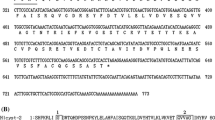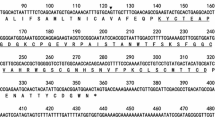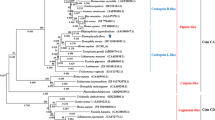Abstract
Ticks feed exclusively on blood to obtain their nutrients, but the gene products that mediate blood-sucking processes in ticks are still unknown. We report here the molecular characterization and possible biological function of a cysteine protease inhibitor (HlSC-1) identified in the salivary gland of the ixodid tick Haemaphysalis longicornis. The HlSC-1 cDNA contains 423 bp that code for 140 amino acids with a predictable molecular weight of 12 kDa. The recombinant HlSC-1 expressed in Escherichia coli was shown to inhibit the activity of papain and cathepsin L, while cathepsin B activity was unaffected. Immunolocalization studies detected the endogenous enzyme in the salivary gland type II acini of an adult tick. Furthermore, quantitative RT-PCR analysis showed that the expression of HlSC-1 transcripts was associated with blood-feeding processes and was highly up-regulated in the early phase of feeding. Our results strongly suggest that HlSC-1 may play pivotal roles in the blood-feeding processes.




Similar content being viewed by others
References
Alim MA, Tsuji N, Miyoshi T, Islam MK, Huang X, Hatta T, Fujisaki K (2008) HlLgm2, a member of asparaginyl endopeptidases/legumains in the midgut of the ixodid tick Haemaphysalis longicornis, is involved in blood-meal digestion. J Insect Physiol 54:573–585
Bendtsen JD, Nielsen H, von Heijne G, Brunak S (2004) Improved prediction of signal peptide: signal P 3.0. J Mol Biol 34:783–795
Colella R, Sakaguchi Y, Nagase H, Bird JW (1989) Chicken egg white cystatin. Molecular cloning, nucleotide sequence, and tissue distribution. J Biol Chem 264:17164–17169
Fawcett DW, Binnington K, Voigt WP (1986) The cell biology of the ixodid tick salivary gland. In: Sauer JR, Hair JA (eds) Morphology, physiology, and behavioral biology of ticks. Ellis Horwood, Chichester, pp 22–45
Fujisaki K, Kawazu S, Kamio T (1994) The taxonomy of the bovine Theileria spp. Parasitol Today 10:31–33
Gong H, Umemiya R, Zhou J, Liao M, Zhang H, Jia H, Nishikawa Y, Xuan X, Fujisaki K (2009) Blocking the secretion of saliva by silencing the HlYkt6 gene in the tick Haemaphysalis longicornis. Insect Biochem Mol Biol 39:372–381
Grunclová L, Horn M, Vancová M, Sojka D, Franta Z, Mares M, Kopácek P (2006) Two secreted cystatins of the soft tick Ornithodoros moubata: differential expression pattern and inhibitory specificity. Biol Chem 387:1635–1644
Harnnoi T, Sakaguchi T, Nishikawa Y, Xuan X, Fujisaki K (2007) Molecular characterization and comparative study of 6 salivary gland metalloproteases from the hard tick, Haemaphysalis longicornis. Comp Biochem Physiol B Biochem Mol Biol 147:93–101
Hoogstraal H, Roberts FH, Kohls GM, Tipton VJ (1968) Review of Haemaphysalis (kaiseriana) Longicornis Neumann (resurrected) of Australia, New Zealand, New Caledonia, Fiji, Japan, Korea, and Northeastern China and USSR, and its parthenogenetic and bisexual populations (Ixodoidea, Ixodidae). J Parasitol 54:1197–1213
Islam MK, Tsuji N, Miyoshi T, Alim MA, Huang X, Hatta T, Fujisaki K (2009) The Kunitz-like modulatory protein haemangin is vital for hard tick blood-feeding success. PLoS Pathog 5:e1000497
Karim S, Miller NJ, Valenzuela J, Sauer JR, Mather TN (2005) RNAi-mediated gene silencing to assess the role of synaptobrevin and cystatin in tick blood feeding. Biochem Biophys Res Commun 334:1336–1342
Kemp DH, Stone BF, Binnington KC (1982) Tick attachment and feeding: role of mouthparts, feeding apparatus, salivary gland secretions and host response. In: Obenchain FD, Galun R (eds) Physiology of ticks. Pergamon, Oxford, pp 119–168
Klompen H (2005) Ticks, the Ixodida. In: Marquardt WC (ed) Biology of disease vectors, 2nd edn. Elsevier, Amsterdam, pp 45–55
Kotsyfakis M, Sá-Nunes A, Francischetti IM, Mather TN, Andersen JF, Ribeiro JM (2006) Antiinflammatory and immunosuppressive activity of sialostatin L, a salivary cystatin from the tick Ixodes scapularis. J Biol Chem 281:26298–26307
Kotsyfakis M, Karim S, Andersen JF, Mather TN, Ribeiro JM (2007) Selective cysteine protease inhibition contributes to blood-feeding success of the tick Ixodes scapularis. J Biol Chem 282:29256–29263
Nuttall PA, Labuda M (2004) Tick–host interactions: saliva-activated transmission. Parasitology 129:S177–189
Rawlings ND, Tolle DP, Barrett AJ (2004a) MEROPS: the peptidase database. Nucleic Acids Res 32:D160–D164 (database issue)
Rawlings ND, Tolle DP, Barrett AJ (2004b) Evolutionary families of peptidase inhibitors. Biochem J 378:705–716
Ribeiro JM (1995) Blood-feeding arthropods: live syringes or invertebrate pharmacologists? Infect Agents Dis 4:143–152
Ribeiro JM, Francischetti IM (2003) Role of arthropod saliva in blood feeding: sialome and post-sialome perspectives. Annu Rev Entomol 48:73–88
Sauer JR, McSwain JL, Bowman AS, Essenberg RC (1995) Tick salivary gland physiology. Annu Rev Entomol 40:245–267
Tsuji N, Kamio T, Isobe T, Fujisaki K (2001) Molecular characterization of a peroxiredoxin from the hard tick Haemaphysalis longicornis. Insect Mol Biol 10:121–129
Tsuji N, Miyoshi T, Battsetseg B, Matsuo T, Xuan X, Fujisaki K (2008) A cysteine protease is critical for Babesia spp. transmission in Haemaphysalis ticks. PLoS Pathog 4:e1000062
Turk V, Bode W (1991) The cystatins: protein inhibitors of cysteine proteinases. FEBS Lett 285:213–219
Vray B, Hartmann S, Hoebeke J (2002) Immunomodulatory properties of cystatins. Cell Mol Life Sci 59:1503–1512
Yamaji K, Tsuji N, Miyoshi T, Islam MK, Hatta T, Alim MA, Anisuzzaman TA, Fujisaki K (2009) Hemoglobinase activity of a cysteine protease from the ixodid tick Haemaphysalis longicornis. Parasitol Int 58:232–237
You M, Xuan X, Tsuji N, Kamio T, Taylor D, Suzuki N, Fujisaki K (2003) Identification and molecular characterization of a chitinase from the hard tick Haemaphysalis longicornis. J Biol Chem 278:8556–8563
Zaim M, Guillet P (2002) Alternative insecticides: an urgent need. Trends Parasitol 18:161–163
Zhou J, Ueda M, Umemiya R, Battsetseg B, Boldbaatar D, Xuan X, Fujisaki K (2006) A secreted cystatin from the tick Haemaphysalis longicornis and its distinct expression patterns in relation to innate immunity. Insect Biochem Mol Biol 36:527–535
Zhou J, Liao M, Ueda M, Gong H, Xuan X, Fujisaki K (2009) Characterization of an intracellular cystatin homolog from the tick Haemaphysalis longicornis. Vet Parasitol 160:180–183
Acknowledgments
This work was supported by Grant-in-Aids (to N.T. and K.F.) from the Ministry of Education, Culture, Sports, Science, and Technology of Japan. This work was also supported by a grant (to N.T. and K.F.) for Promotion of Basic Research Activities for Innovative Biosciences from the Bio-oriented Technology Research Advancement Institution.
Author information
Authors and Affiliations
Corresponding author
Rights and permissions
About this article
Cite this article
Yamaji, K., Tsuji, N., Miyoshi, T. et al. A salivary cystatin, HlSC-1, from the ixodid tick Haemaphysalis longicornis play roles in the blood-feeding processes. Parasitol Res 106, 61–68 (2009). https://doi.org/10.1007/s00436-009-1626-3
Received:
Accepted:
Published:
Issue Date:
DOI: https://doi.org/10.1007/s00436-009-1626-3




